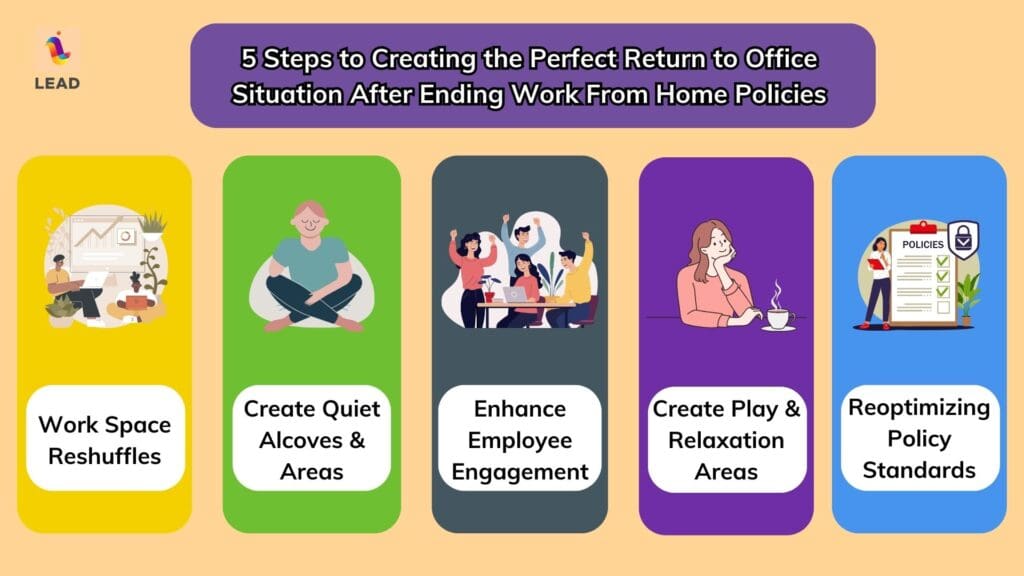Work from home is getting a rethink from many businesses around the world. As companies return to their old ways, a lot of executives want employees return to office. Of course, most people are not inclined towards 5 days of work per week anymore. And indeed. Getting people back to work might prove to be a challenge, even at the mid-line managerial level.
A recent Gartner study revealed that mid-level managers are even more reluctant to come back to work like before the pandemic than employees. A lot of them do not find it optimal to come to the office when they can manage operations right from their home or anywhere else. Of course, when the managers are not inclined to get back, expecting remote and hybrid workers to move back will be a farshot. A recent Inc.com article even declared that RTO mandates are dead.
So, the question looming for many businesses is how to implement a return-to-office mandate without losing talent. Clearly, there are many opportunities available to skilled professionals and talent retention must remain a top priority for all enterprises. But if they want to implement a return to work policy, they must consider a viable alternative to the remote work solution. Here are 5 pointers to help them develop their own process for getting their workforce back in the office for good:


5 Steps for creating the perfect return to office situation in 2024
5 Steps to Creating the Perfect Return to Office Situation for Successful Return-to-Office
Work Space Reshuffles
Key Takeaways:
-
Downsized workspaces may not have enough to fit all employees.
-
Old spaces may be sub-optimized for collaboration in a post-pandemic world.
-
The office ambiance and décor might need improvement with expert advice.
Workspaces have shrunk significantly since the pandemic went full bore on the world economy. This is a problem for businesses now that must reconsolidate existing space while looking to either lease or purchase more. But until that time, they will need to reuse space and optimize it for work. For this, they need to consider factors like collaboration ease, communication channels, and noise levels. We will take up noise levels subsequently in further detail. But considering workspace collaboration and communication come first.
Ideally, your new designs for making your return to office mandates design needs to follow seamlessly from one space to the other. For example, if you are an industrial corporate firm then linking departments together for easy workflow makes sense. As an example, the manufacturing team can sit next to sales or quality assurance. However, when you design your workflow, it needs to reflect the best practices in the industry by optimal spacing and organization. Once the workspace flow and logistics have been organized, your workers can better process daily work. And with the right kind of incentives that we will mention below, they just might feel like coming to work more often.
Create Quiet Alcoves & Areas
Key Takeaways:
-
Quiet spaces are fast rising in demand because office noise levels are higher now.
-
Quiet spaces turn into learning areas or high-productivity zones
-
Such areas are ideal for employees with ADHD or neurodivergence.
Quiet spaces are rising in demand by a lot in the business world, espcially since the call return to office . There has been a recognition that working from home has made employees noisier and more unmindful of other people’s space. According to a 2021 study quoted in this article on Forbes, the louder noise is making people cringe more and also increasing psychological stress indicated by higher heart rates. Obviously, this is best deterred by reorganizing spaces and ensuring individuals can work as they want to.
Moreover, real innovation work does not happen in open environments but requires closed spaces to work to the best effect. This also applies to mentorships and learning processes which also require quiet places for deeper contemplation. Also, when following a return to office mandate employees with special needs such as those with neurodivergence or otherwise autism like ADHD need quieter spaces to work. Understanding and curating office workspaces as per the needs of the people is the best way to create a work-from-office compulsion.
TLDR? Get all the big highlights in 60 secs or less in this video!
Enhance Employee Engagement
Key Takeaways:
-
Increasing engagement and creating strong cross-team collaboration helps bring people back to work
-
Virtual coffee chats, water cooler sessions, and mentorships can help companies generate better collaboration and organizational networking.
-
Employee engagement is best done through Team collaboration tools like Slack or MS Teams
Working up employee engagement when people are working remotely is a nightmare. Of course, apps like LEAD.bot offer engagement options right from collaboration tools like MS Teams and Slack. However, if you did not pursue employee engagement goals before going remote, then it is likely that you’ll need to work up a plan. This is where using apps like LEAD.bot and their multiple employee engagement features help in working up a strong team collaboration culture. Using them helps in creating work systems and interaction mechanisms that boost the human element of business. Virtual coffee chats enable workers to interact with one another and build team bonds.
Using employee engagement mechanisms and things like the buddy system, companies can develop strong working bonds and entice people to return to the office. While return to office mandates might be dead, they certainly do not mean hybrid work cultures will not thrive. Creating a workspace that can afford a revolving roster of professionals in the office will help in developing a solid workflow both at work and remotely.
Create Play & Relaxation Areas
Key Takeaways:
-
Play & recreation impact employee presenteeism, performance and
-
Businesses can greatly increase innovation with the right recreational facilities.
-
Further engagement options include play teams, tournaments, awards, etc.
One of the biggest problems with the dialogue in business about worker happiness has to do with perks and benefits. The ideal way to do them is to work them up for the best benefit of the company as this CEO magazine article mentions. Perks may include allowances, reimbursements for expenses made for working with the company, etc. The benefit might include any advantages catering to special needs or lifestyle-related benefits like paternity leaves or allowances. In addition, companies using return to office mandates can use team-building exercises in the form of play and recreation. They can build strong working relations both within teams and with other departments. Another recent CEO magazine article highlights the need for play and its several benefits. Check it out here.
Further, a lot of companies have made major investments in perks and benefits but did not see any major returns. This is because they made welfare or indulgence-based investments instead of practical in-office ones. Companies that want to operate on a largely hybrid model should consider implementing perks and benefits like play and recreation in the form of teams and tournaments. This is a good way to entice workers to adopt more in-office and employee engagement tools like LEAD.app are a great addition to engage remote and hybrid workers.


Reasons remote workers do not want to return to office
Reoptimizing Policy Standards
Key Takeaways:
-
Balanced work policies between mandatory office days and work-from-home days strike a good balance.
-
Companies should consider parenting and maternity leave benefits as well.
-
Creating cross-team collaboration with the right tech tools and communication strategy stands offers the best team performance potential.
A lot of remote workers do not want to return to work since they have their lifestyles to manage aside from work. So, developing a balanced employment approach that enables a healthy work-life balance helps create an optimal work output environment. Plus, employee engagement with cross-team collaboration using remote working tools negates the chances of work getting sidetracked.
In other areas, policies for parenting support enable employees to handle their familial obligations better. Companies with return to office mandates can also consider parenting allowances to help working parents raise their children better. This creates an optimal work-life balance and implementing hybrid work policies may entice them to come to the office in such cases. Plus, using team collaboration and remote working tools while they are off-site via virtual coffee chats or water cooler sessions will create a constant engagement and give them more incentives to come to work.
Are You Ready to Get your Return to Office Policies Right?
Return-to-office mandates simply do not work without incentives to come to work. Companies with employee engagement based on effective collaboration tactics will benefit the most from both on-site and off-site workers. For this purpose, team engagement and collaboration tools like LEAD.bot are the best remote working solutions.
LEAD.bot is a team engagement platform available on Slack and Teams. It is an all-in-one team development software with features like virtual coffee chats, buddy programs, birthday celebrations & work anniversary celebrations, new hire onboarding programs, and Pulse Surveys.
LEAD.bot also offers cutting-edge Organizational Network Analysis (ONA) for big enterprises and institutions. Executive to mid-level managers use ONA to gain highly actionable insights and build strong workplace connections. Using this app enables developing innovative employee engagement ideas to connect employees and foster better organizational health, employee retention, and overall performance with this simple app!
LEAD.bot is a product of LEAD.app and we also LEAD.bot’s sister app Sunrize which showcases workplace attendance by graphs right on Slack! Book a demo now!












